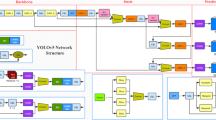Abstract
Currently, human-vehicle recognition (HVR) method has been applied in road monitoring, congestion control, and safety protection situations. However, traditional vision-based HVR methods suffer from problems such as high construction cost and low robustness in scenarios with insufficient lighting. For this reason, it is necessary to develop a low-cost and high-robust HVR method for intelligent street light systems (ISLS). A well-designed HVR method can aid the brightness adjustment in ISLSs that operate exclusively at night, facilitating lower power consumption and carbon emission. The paper proposes a novel wireless sensing-based human-vehicle recognition (WsHVR) method based on deep learning technologies, which can be applied in ISLSs that assembled with wireless sensor network (WSN). To solve the problem of limited recognition ability of wireless sensing technology, a deep feature extraction model that combines multi-scale convolution and attention mechanism is proposed, in which the received signal strength (RSS) features of road users are extracted by multi-scale convolution. WsHVR integrates an adaptive registration convolutional attention mechanism (ARCAM) to further feature extraction and classification. The final normalized classification result is obtained by SoftMax function. Experiments show that the proposed WsHVR outperforms existing methods with an accuracy of 99.07%. The dataset and source code related to the paper have been published at https://github.com/TZ-mx/WiParam and https://github.com/TZ-mx/WsHVR, respectively. The proposed WsHVR method has high performance in the field of human-vehicle recognition, potentially providing valuable guidance for the design of intelligent streetlight systems in intelligent transportation systems.








Similar content being viewed by others
Data Availability
The dataset and source code related to the paper have been published at https://github.com/TZ-mx/WiParam and https://github.com/TZ-mx/WsHVR, respectively.
References
Tewolde GS. Sensor and network technology for Intelligent Transportation Systems. In: 2012 IEEE International Conference on Electro/Information Technology. IEEE; 2012. p. 1–7.
Zhang R, Jing X, Wu S, Jiang C, Mu J, Yu FR. Device-free wireless sensing for human detection: the deep learning perspective. IEEE Internet Things J. 2021;8:2517–39.
Wang Q, Zheng J, Xu B, Huang Y. Analysis and experiments of vehicle detection with magnetic sensors in urban environments. In: 2015 IEEE International Conference on Cyber Technology in Automation, Control, and Intelligent Systems (CYBER). IEEE; 2015. p. 71–5.
Alexander AA, Taylor R, Vairavanathan V, Fu Y, Hossain E, Noghanian S. Solar-powered Zigbee-based wireless motion surveillance: a prototype development and experimental results. Wirel Commun Mob Comput. 2008;8:1255–76.
Yang Z, Pun-Cheng LSC. Vehicle detection in intelligent transportation systems and its applications under varying environments: a review. Image Vis Comput. 2018;69:143–54.
Rajab S, Al Kalaa M, Refai H. Classification and speed estimation of vehicles via tire detection using single-element piezoelectric sensor. J Adv Transp. 2016;50:1366–85.
Zhang J, Lu Y, Lu Z, Liu C, Sun G, Li Z. A new smart traffic monitoring method using embedded cement-based piezoelectric sensors. Smart Mater Struct. 2015;24: 025023.
Chadwick S, Maddern W, Newman P. Distant vehicle detection using radar and vision. In: 2019 International Conference on Robotics and Automation (ICRA). IEEE; 2019. p. 8311–7.
Ward E, Folkesson J, Vehicle localization with low cost radar sensors. In: IEEE Intelligent Vehicles Symposium (IV). IEEE. 2016;2016:864–70.
Addesso P, Di Mauro M, Longo M, Corte GD, Robustelli AL. An indoor localization system within an IMS service infrastructure. In: Proceedings of International Conference on Advances in Mobile Computing & Multimedia - MoMM ’13. 2013. p. 321–5. https://doi.org/10.1145/2536853.2536926.
Kong F, Zhou Y, Chen G. Multimedia data fusion method based on wireless sensor network in intelligent transportation system. Multimedia Tools and Applications. 2019;79:35195–207.
Wang T, Yang D, Zhang S, Wu Y, Xu S. Wi-alarm: low-cost passive intrusion detection using WIFI. Sensors. 2019;19:2335.
Wang J, Tian Z, Zhou M, Wang J, Yang X, Liu X. Leveraging hypothesis testing for CSI based passive human intrusion direction detection. IEEE Trans Veh Technol. 2021;70:7749–63.
Wang F, Han J, Lin F, Ren K, WiPIN: operation-free passive person identification using Wi-Fi signals. In,. IEEE Global Communications Conference (GLOBECOM). IEEE. 2019;2019:1–6.
Song M, Lou L, Chen X, Zhao X, Hong Y, Zhang S, et al. Wi-LADL: a wireless-based lightweight attention deep learning method for human–vehicle recognition. IEEE Sens J. 2023;23:2803–14.
Song M, Zhu R, Chen X, Zheng C, Lou L. A lightweight attention deep learning method for human-vehicle recognition based on wireless sensing technology. Front Neurol. 2023;17:1135986.
Haferkamp M, Al-Askary M, Dorn D, Sliwa B, Habel L, Schreckenberg M, Wietfeld C. Radio-based traffic flow detection and vehicle classification for future smart cities. In 2017 IEEE 85th Vehicular Technology Conference (VTC Spring). IEEE; 2017. p. 1–5. https://doi.org/10.1109/VTCSpring.2017.8108633.
Lee W-H, Liang T-J, Wang H-C. An innovative and cost-effective traffic information collection scheme using the wireless sniffing technique. Vehicles. 2022;4:996–1011.
Chen C, Ota K, Dong M, Yu C, Jin H. WITM: intelligent traffic monitoring using fine-grained wireless signal. IEEE Transactions on Emerging Topics in Computational Intelligence. 2020;4:206–15.
Chen J, Wang H, He E. A transfer learning-based CNN deep learning model for unfavorable driving state recognition. Cognitive Computation. 2023. https://doi.org/10.1007/s12559-023-10196-7.
Won M, Sahu S, Park K-J. DeepWiTraffic: Low cost WIFI-based traffic monitoring system using deep learning. In: 2019 IEEE 16th International Conference on Mobile Ad Hoc and Sensor Systems (MASS). IEEE; 2019. p. 476–84.
Ma T-M, Shi Y-S, Wang Y-G. A low complexity MMSE for OFDM systems over frequency-selective fading channels. IEEE Commun Lett. 2012;16:304–6.
Long J, Shelhamer E, Darrell T. Fully convolutional networks for semantic segmentation. In: 2015 IEEE Conference on Computer Vision and Pattern Recognition (CVPR). IEEE; 2015. p. 3431–40.
Howard A, Sandler M, Chen B, Wang W, Chen L-C, Tan M, et al. Searching for MobileNetV3. In: 2019 IEEE/CVF International Conference on Computer Vision (ICCV). IEEE; 2019. p. 1314–24.
Li S, Liu D, Liu X, Ma Y, Gu X, Fan Y, et al. CSI-based vehicle target recognition and collaborative CNN with data-importance-aware. In: 2022 IEEE 25th International Conference on Intelligent Transportation Systems (ITSC). IEEE; 2022. p. 2069–74.
Lou L, Zhou M, Chen B, Lu M, Zheng C, Zhang S. An environmental energy harvesting-driven wireless parking detection method: analysis and implementation. IEEE Trans Intell Transp Syst. 2023;24:10186–96.
Kapoor A, Mishra R, Kumar P. Frequency selective surfaces as spatial filters: fundamentals, analysis and applications. Alex Eng J. 2022;61:4263–93.
Achyunda Putra FA, Utaminingrum F, Mahmudy WF. Hog feature extraction and KNN classification for detecting vehicle in the highway. Indones J Comput Cybern Syst. 2020;14:231.
Chauhan VK, Dahiya K, Sharma A. Problem formulations and solvers in linear SVM: a review. Artif Intell Rev. 2018;52:803–55.
Kanschat R, Gupta S, Degbelo A. Wireless-Signal-based vehicle counting and classification in different road environments. IEEE Open Journal of Intelligent Transportation Systems. 2022;3:236–50.
Alzubaidi L, Bai J, Al-Sabaawi A, Santamaría J, Albahri AS, Al-dabbagh BS, et al. A survey on deep learning tools dealing with data scarcity: definitions, challenges, solutions, tips, and applications. J Big Data. 2023;10:46.
Al-Timemy AH, Ghaeb NH, Mosa ZM, Escudero J. Deep transfer learning for improved detection of keratoconus using corneal topographic maps. Cogn Comput. 2021;14:1627–42.
Funding
This work was supported by Zhejiang Provincial Public Welfare Project of China Grant No. LGG22F030009 and National Natural Science Foundation of China under the Grant No. 62106168.
Author information
Authors and Affiliations
Corresponding author
Ethics declarations
Competing Interest
The authors declare no competing interests.
Additional information
Publisher's Note
Springer Nature remains neutral with regard to jurisdictional claims in published maps and institutional affiliations.
Rights and permissions
Springer Nature or its licensor (e.g. a society or other partner) holds exclusive rights to this article under a publishing agreement with the author(s) or other rightsholder(s); author self-archiving of the accepted manuscript version of this article is solely governed by the terms of such publishing agreement and applicable law.
About this article
Cite this article
Lou, L., Cai, R., Lu, M. et al. A Novel Method for Human-Vehicle Recognition Based on Wireless Sensing and Deep Learning Technologies. Cogn Comput (2024). https://doi.org/10.1007/s12559-024-10276-2
Received:
Accepted:
Published:
DOI: https://doi.org/10.1007/s12559-024-10276-2




